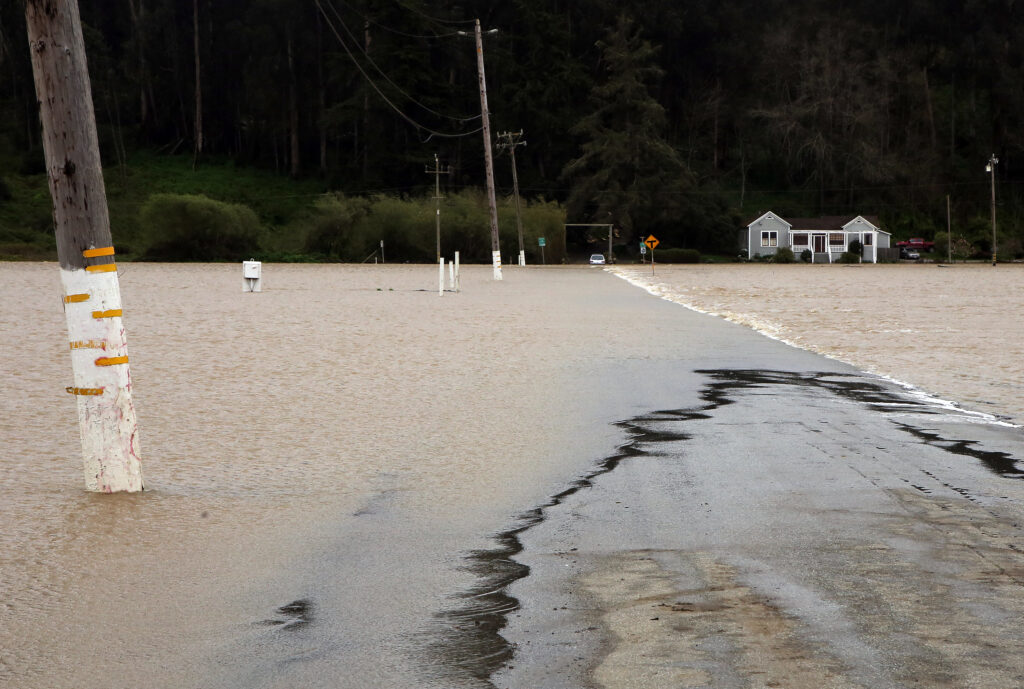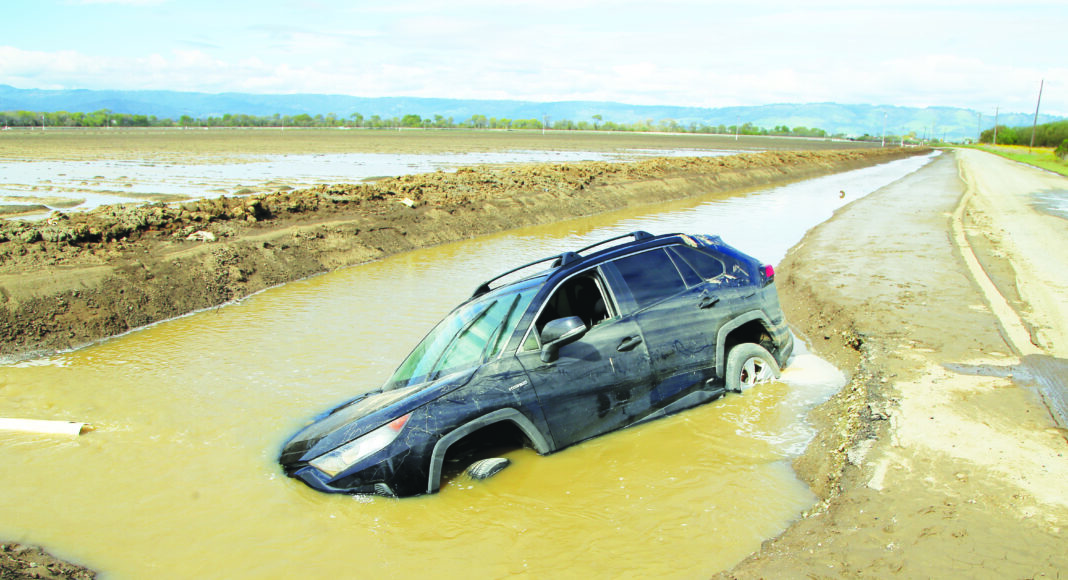Shortly after a breach in the Pajaro Levee caused torrents of water to flood the tiny town of Pajaro on March 11, work crews temporarily plugged the breach. Now, officials hope to permanently repair the levee by banking on a law that will call in the U.S. Army Corps of Engineers (ACOE).
Under Public Law 84-99, which covers emergency assistance in response to flood and coastal storms, repairs usually take two years. But Pajaro River Flood Management Agency Director Mark Strudley says the agency is asking for the levee’s repairs to be expedited and completed by summer.
Even after repairs, he says, the old levee system—which holds the Pajaro River back from the agriculture fields and neighborhoods in both Monterey and Santa Cruz Counties—is rife with weakness that could mean more flooding in future years.
“There are plenty of vulnerabilities elsewhere,” he says. “That’s probably why the levee broke. They’re old, they’re undersized, they were poorly built to different engineering standards in the ’40s. Things wear out. Things have a useful design life to them, and they are well past that.”
Indeed, the levee—built in 1949—flooded in 1955, 1958, 1995 and 1998. Despite decades of discussions, an upgrade authorized in 1966 by the Federal Flood Control Act never got off the ground.
The levee is now due for a $400 million upgrade, with some optimistic estimates putting the start date within two years and others saying it could be longer.
The federal government has kicked in $149 million for the project. The state’s share—up to $181 million—covers the remaining costs.
The last piece of this puzzle fell into place when roughly 3,000 property owners along the levee system last year approved an assessment on their annual property tax bills. That money will fund the $1.2 million annual maintenance and operations.
In a March 27 letter to U.S. Army Corps of Engineers Assistant Secretary Michael Connor, Senators Alex Padilla and Dianne Feinstein joined with Congresspeople Jimmy Panetta and Zoe Lofgren to ask that the project and its funding be expedited.
But that’s not an easy task. Before any work happens, officials must hack through a mountain of red tape, including environmental review and permitting, as well as land acquisitions and easements. The pre-work also includes moving power poles and elevating bridges.
These requirements, he says, are part and parcel of any major construction project and move along their own timeline.
“We’ll try to make them go as quickly as we can, but there is nothing you could do to write them into state law or hardwire a faster process,” he says.
The promise of 100-year flood protection is cold comfort for residents who live along the levee and have endured five devastating floods. It’s no accident that most of those impacted by the floods are low-income agricultural laborers, says Monterey County Supervisor Luis Alejo.
“Historically, what happened to Pajaro is a story that has happened to marginalize poor communities, communities of color, throughout history,” he says.
Alejo points to San Lucas, a community of roughly 500 farmworkers along Hwy 101, grappling with water quality issues for years.
As a state Assemblyman, Alejo got the California State Water Resources Control Board to approve an $8 million pipeline that would have brought clean water from King City. But one year later, the project was stopped after officials cited the high cost.
“For me, that is a more recent example of a disadvantaged community where the state, even after giving approval, backs out because they thought that costs were too high per household for disadvantaged farmworker communities,” he says.
The board recently began factoring racial equity into its decisions.
“We are changing how we do business and re-looking at communities that have historically not received the resources they deserve,” Alejo says. “We are now trying to deliver them. That is our commitment to those communities.”
Second District Supervisor for Santa Cruz County Zach Friend agrees that economics have played a role in the sizable time span it has taken to move the levee upgrade forward.
“Pajaro is the tip of the iceberg in a federal system that unequivocally has discriminated against low-income communities in funding federal flood control projects,” he says.
But this story is not unique to Pajaro. The problem, Friend says, is a 1:1 benefit-cost ratio used by ACOE when calculating the feasibility of a project that calls for one dollar of savings for every dollar spent.
That means a community with million-dollar homes will take precedence over one with lower property values, leaving low-income areas in the lurch. Agricultural communities fare even worse since the ACOE places a zero on that land in the ratio.
“So, the most hurt is low-income, rural and ag communities,” Friend says. “Our story shouldn’t have happened. For years we have been yelling from the rooftops to anyone who would listen—the underlying system is broken; the coldness of their economic calculations not only discounts human suffering but ensures low-income communities can’t compete. While there seemed to be agreement at many levels, change has been painfully slow.”

Alejo, who began his career as an elected official on the Watsonville City Council before moving to the Assembly and then to the Monterey County Board of Supervisors, says one of his focuses has been securing funding for the levee upgrade.
That dream was realized in October when a cadre of local, state and federal officials gathered at Atri Park—a tiny community space abutting the levee—to celebrate the full funding of the project.
While that vote was the apex of two years of work by state and federal lawmakers, Alejo says it is now vital to ensure the funds are in the bank, especially with an expected economic recession looming.
“In light of everything that has happened in Pajaro, we need to expedite this project to move along quicker, to prevent another flood from happening in the future,” he says. “Considering it’s a project that is going to take numerous years, we don’t want our state and federal agencies to bail out and not fulfill their promises to the communities on both sides of the Pajaro River.”
Strudley says that if the money comes in all at once, it will allow for a design-build approach, meaning a single contractor could see the project to completion. He says that could accelerate the timeline.
If it comes in piecemeal, it might stretch out the completion time. Either way, the funding is assured, as is the overall project.
“I don’t want people to lose faith in this project,” Strudley adds. “It’s heartbreaking what’s been going on with the flood, but everything is still on track with the overall levee construction project.”














Good article. No surprise that the levee didn’t get fixed. ‘Land has no value’ per those assessments.’ Jobs & our food supply are more valuable than a million dollar housing community.
BTW, it’s Dianne Feinstein, small edit.
Verification re my post:
804470
Apparently you’ve dumped my post before I could retrieve the verification #
804470
This is a shorter response from my own Facebook page:
~ “Compare the $$$ numbers in this story, and the $$$ numbers for the Silicon Valley Bank’s bail out – but also notice how much the head of SVB took out weeks before it collapsed! There oughtta be a rethinking of ‘risks’ and protecting the ‘work’ of even the ‘little people’ who work hard for their money!”
https://www.msnbc.com/…/deregulation-silicon-valley…
Verification # 804470
And who the heck is Friend? Your article references this person three times without a first name or title anywhere within. ?